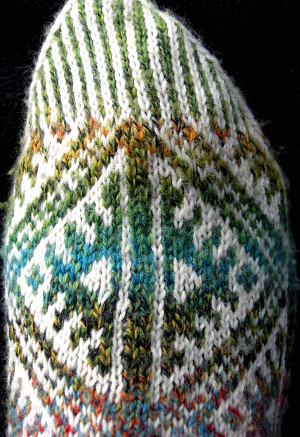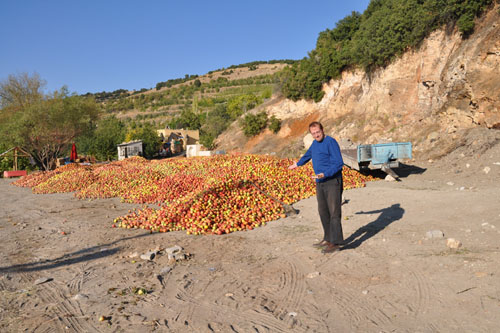I discovered something fascinating last week, just by accident.
Noel and I take a weekly Turkish class, and I often have knitting with me to work on until class starts (at which point both brain and hands are actively engaged in the class). Anyway, we got onto the subject of Turkish socks, which are sort of notorious there in the same way that those foam cheese heads are famous here. Our teacher said, "we call them baklava socks."
And then it clicked for me. I have Anna Zilboorg's very fine book Simply Socks (also published as Fancy Feet). In it there is a pattern that confused me, because it is called "apple," but it looks absolutely nothing like an apple.
Look:
That's a photo of one of a pair of lovely socks knitted by Flickr user hiddimaus, and that big central diamond pattern there is the "apple" pattern. (The Ravelry project page for these socks is here.)
Now, Turks know their apples.
This is Noel next to one of many many enormous piles of apples we saw while driving around in the countryside. No Turkish peasant would be at all confused about what an apple looks like. And other patterns that are meant to look like things like dogs or knives or mustaches actually kind of look like the thing in question. So why is the pattern called "apple" when it so obviously is not an apple?
As it happens, a native speaker of English (and most other European languages) may not know that in Turkish, you pluralize words by adding "-lar" or "-ler" (depending on the rules of vowel harmony that don't matter much right now), rather than by adding an "s" as we do. And for reasons that can only be full understood if you grow up with a Turk, there are a lot of words that look and sound similar that mean totally different things. So if a native English speaker looks up the word "elmas" in the translating dictionary, they are likely to stop at "elma" which means "apple," assuming the "s" just makes it plural, rather than continuing down to "elmas" which means, of all things, "diamond."
The pattern is a diamond. Elma means apple, elmalar means apples, and elmas means diamond (elmaslar means diamonds).
This is what can happen when you translate blindly with a dictionary.



Hmm, interesting! So why are they called baklava socks?
Traditionally, baklava is cut into diamonds. So the diamond pattern up the leg looks like a tray of baklava.